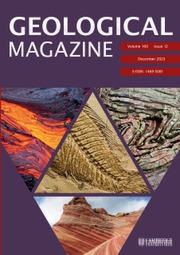Crossref Citations
This article has been cited by the following publications. This list is generated based on data provided by
Crossref.
Liu, Zheng
Liao, Shi-Yong
Tan, Shu-Cheng
He, Xiao-Hu
Wang, Guo-Chang
Wang, Dong-Bing
and
Zhou, Qing
2019.
Paleocene Neo-Tethyan slab rollback constrained by A1-type granitic intrusion in the Gaoligong–Tengliang–Yingjiang belt of the Eastern Himalayan Syntaxis, SE Tibet.
International Journal of Earth Sciences,
Vol. 108,
Issue. 6,
p.
2113.
Zhang, Jibiao
Ding, Xiaozhong
Liu, Yanxue
Zhang, Heng
Shi, Chenglong
and
Zou, Yu
2020.
Geochronology and Geochemistry of the 890 Ma I-Type Granites in the Southwestern Yangtze Block: Petrogenesis and Crustal Evolution.
Journal of Earth Science,
Vol. 31,
Issue. 6,
p.
1216.
Zong, Zhao-Jian
Du, Yang-Song
Li, Shun-Ting
Cao, Yi
Du, Jing-Guo
Deng, Xiao-Hua
and
Xue, Li-Wei
2021.
Petrogenesis of the early Permian A-type granites in the Halajun region, southwest Tianshan, western Xinjiang, NW China: implications for geodynamics of Tarim large igneous province.
International Geology Review,
Vol. 63,
Issue. 9,
p.
1110.
Sun, Li
Wang, Wei
Pandit, Manoj K.
Lu, Guimei
Xue, Erkun
Huang, Bin
Zhang, Yang
Jin, Wei
and
Tian, Yang
2022.
Geochemical and detrital zircon age constraints on Meso- to Neoproterozoic sedimentary basins in the southern Yangtze Block: Implications on Proterozoic geodynamics of South China and Rodinia configuration.
Precambrian Research,
Vol. 378,
Issue. ,
p.
106779.
Lu, Gui-Mei
Spencer, Christopher J.
Deng, Xin
Tian, Yang
Huang, Bin
Jiang, Ying-De
and
Wang, Wei
2022.
Mesoproterozoic magmatism redefines the tectonics and paleogeography of the SW Yangtze Block, China.
Precambrian Research,
Vol. 370,
Issue. ,
p.
106558.
Zhang, Jibiao
Ding, Xiaozhong
Liu, Yanxue
Liu, Peiwen
Shi, Chenglong
and
Zhang, Heng
2023.
The ca. 1.13–0.92 Ga magmatism in the western Yangtze Block, South China: Implications for tectonic evolution and paleogeographic reconstruction.
Precambrian Research,
Vol. 386,
Issue. ,
p.
106961.
Wang, Zhenzhen
Zhao, Zhidan
Li, Xuping
Meng, Yuanku
Liu, Dong
Mo, Xuanxue
Lv, Jun
and
Cong, Fuyun
2023.
Early Jurassic A-type granitoids in the Xing'an block constrain on the spatial extent of the Paleo-Pacific tectonic regime.
Lithos,
Vol. 460-461,
Issue. ,
p.
107390.
Amaral, João Lains
Solá, Ana Rita
Bento dos Santos, Telmo M.
Feitoza, Lorena
Tassinari, Colombo
Crispim, Lourenço
Chichorro, Martim
Zieger-Hofmann, Mandy
Gärtner, Jessica
Linnemann, Ulf
and
Gonçalves, João
2024.
The bimodal Fii-A2-type and calc-alkaline volcanic sequence of the Aljustrel brownfield region, Iberian Pyrite Belt, SW Iberian Massif.
Geochemistry,
Vol. 84,
Issue. 1,
p.
126049.
Chen, Fenglin
Wang, Jian
Cui, Xiaozhuang
Lin, Shoufa
Ren, Guangming
Deng, Qi
Huang, Mingda
Li, Kuizhou
and
Shen, Lijun
2024.
A latest Mesoproterozoic arc–back-arc system in the southwestern Yangtze Block, South China: Implications for paleogeographic configuration of the Rodinia supercontinent.
Precambrian Research,
Vol. 409,
Issue. ,
p.
107432.
Wang, Kai
Zhang, Shuan-Hong
Zhang, Qiqi
and
Zhao, Tianyu
2024.
Late Mesoproterozoic continental rifting during the assembly of Rodinia: Evidence from low-δ18O A-type granites and associated volcanic rocks in the Tieshajie Complex, eastern South China.
Precambrian Research,
Vol. 409,
Issue. ,
p.
107450.




